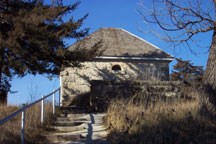
NPS Photo Winters were generally colder on the prairie in the 1800s and rivers would freeze solid. The Cottonwood River had an ice cutting factory and large blocks of ice were scored and cut by an ice plow, then sold. Blocks of ice were then carried, by wagon, to the icehouse for storage. For insulation against melting, ice was stored among layers of prairie hay and sawdust. There is an old saying that the rich man gets his ice in the summer, while the poor man gets his ice in the winter. From this one could surmise that Mr. Jones was the rich man in the story, as he had ice all year long. Try to imagine the blocks of ice that would be stored in this structure. 
NPS Photo, winter 2002 The icehouse was built of native limestone in 1882. The original doorway was located on the north face of the building. Placing the entrance on the north side of a building denies sunlight from reaching the ice. Also, some icehouses placed the entrance several feet off the ground, because the interior cold air (from the ice) flows downward. Keeping the entrance to the building near the top, would not allow this interior cold air to escape. In the 1887 Spring Hill Ranch lithograph, the original dormer and access door can be seen on the north side in the upper portion of the roofline. The roof has changed over the years, but still visible inside is the original framing for the dormer and doorway. Over the years the icehouse was adaptively used as a garage and workshop, making it necessary to widen the entrance and move it around to the south side for greater usability and access to sunlight. The following excerpt was taken from The Good Old Days, Ice Harvest, R.J. McGinnis, F. & W. Publishing Company, Cincinnati, Ohio, pages 121-122.) "Icehouses, once common enough on the better farms of America, have with few exceptions, long ago been made over into extra chicken houses or split up into kindling wood....To put up ice one must have good water - a pond or lake, a river or stream with a sizable pool of deep water. Many of the first farm ponds were built, not to supply water, but to supply ice. The ice harvest usually came toward the end of January or early in February, when the ice was about ten inches thick. The best temperature for cutting was a few degrees below freezing, so the water would freeze quickly on the cakes after they were taken out of the pond, but it seemed that it never was a pleasant twenty-five degrees; frequently it was zero or below. Men did not dare to wait, for too often a zero spell in the Northern states is followed by a thaw which would spoil the ice. After the snow was scraped from the area, the ice was plowed out. The ice plow was a weighted, horse-drawn contrivance with a row of sharp teeth which cut a narrow furrow six or seven inches deep. A marker scratched a line for the next cut. The plow was run one way over an area, then over the other at right angles, plowing out a checkerboard pattern of cakes of a more or less standard size, 22 inches by 12 inches, weighing about a hundred pounds. Sometimes the cakes were broken apart with a boar, but particular people liked to have the edges smooth, so the last two or three inches were sawed by hand. The ice saw was straight-bladed and four or five feet in length with a handle like a lawn mower. After the cakes were cut, they were poled through the dark water to shore. Here a long plank sloped into the water; the trick was to give the cake of ice enough momentum so that its weight would carry it up where someone with a pair of tongs could snag it..... the ice was hauled to the icehouse on two-horse bobsleds. Layer by layer the old weathered icehouse was filled. A sprinkling of dry sawdust was scattered between each layer of cakes. This made them easier to separate when they were taken out. A two-foot-wide layer of sawdust was tamped lightly between the ice and sides of the building. After the last layer was pushed up the long, oak plank, the whole heap was covered a yard deep with sawdust. Some farmers not only cut ice for their own needs, but for neighbors. The going price was five cents a cake. But the thrifty farmers wanted their own ice-cutting equipment. It took an average of three hundred cakes to last a family through the summer; at five cents a cake this was fifteen dollars, one-third the price of a good cow....No one knows when a farsighted colonial farmer first conceived the idea of storing ice to use in hot weather. Old records reveal that many icehouses were built in New England after the Revolution."
Virtual Tour Home |
Last updated: February 26, 2022
